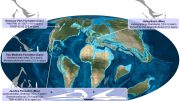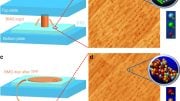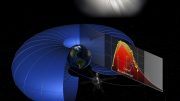
Artist’s impression of asteroid Crantor near Uranus. Credit: SINC
In two new studies, researchers confirm that the 70km asteroid Crantor and two smaller asteroids (2010 EU65 and 2011 QF99) are co-orbiting with Uranus.
Astrophysicists from the Complutense University of Madrid have confirmed that Crantor, a large asteroid with a diameter of 70 km has an orbit similar to that of Uranus and takes the same amount of time to orbit the Sun. Researchers have demonstrated for the first time that this and a further two objects of the group of the Centaurs are co-orbital with Uranus.
Uruguayan astronomer Tabaré Gallardo suggested in 2006 that the asteroids Crantor and 2000 SN331 complete their orbits of the Sun in the same time period as Uranus – an orbit of approximately 84 Earth years. Now two researchers at the Complutense University of Madrid (UCM) have confirmed that in the case of Crantor this is true.
“The simulations we have carried out in the Data Processing Centre of the UCM indicate that 2000 SN331 does not have 1:1 commensurability with Uranus, but Crantor does, which means it orbits the Sun in exactly the same time period as the planet,” Carlos de la Fuente Marcos, one of the authors of the study, explains to SINC.
In addition, Crantor’s orbit has a very similar semi-major axis to that of Uranus, although its eccentricity and inclination vary. The trajectories, figures and animations are published in the journal Astronomy & Astrophysics.
“This 70 km-wide asteroid’s orbit is controlled by the Sun and Uranus but is unstable due to disturbances from nearby Saturn,” states De la Fuente Marcos.
The researcher also reveals that they found another object, which has been named 2010 EU65 and moves in a similar orbit to Crantor’s, “although much more stable because its trajectory is less eccentric.”
Similarly, the latest data of a third asteroid, 2011 QF99 – the discovery of which was made public only a few weeks ago – also indicate that its orbit is in line with that of Uranus.
According to the Minor Planet Center, the regulating body for the naming of asteroids and comets, the three objects that “follow” Uranus belong to the group of the Centaurs. These icy planetoids endowed with a mythological name orbit the Sun between Jupiter and Neptune.
“Crantor, 2010 EU65 and 2011 QF99 are the first bodies to be documented as co-orbiting with Uranus,” affirms De la Fuente Marcos, “although with distinct movements and trajectories.”
Horseshoe and tadpole orbits
From the point of view of an observer rotating along with Uranus, both Crantor and 2010 EU65 have “horseshoe” orbits, since they acquire this form as they move towards and away from the planet. In fact, these two centaurs periodically have close encounters with Uranus.
However, 2011 QF99 maintains a more stable, Trojan or “tadpole” orbit, which means that it moves 60 degrees in front of Uranus. This asteroid always maintains a relatively large distance from the planet.
The scientists calculate that the orbits of these three objects associated with Uranus could remain stable for a few million years. In astronomical terms this is not very long. With the Data Processing Centre’s simulations, the same team has identified three new Mars Trojan asteroids with stable orbits of up to 10,000 million years.
References:
“Crantor, a short-lived horseshoe companion to Uranus” by C. de la Fuente Marcos and R. de la Fuente Marcos, 5 March 2013, Astronomy & Astrophysics.
DOI: 10.1051/0004-6361/201220646
arXiv:1301.0770
“Three new stable L5 Mars Trojans” by C. de la Fuente Marcos and R. de la Fuente Marcos, 26 March 2013, Monthly Notices of the Royal Astronomical Society: Letters.
DOI: 10.1093/mnrasl/slt028
arXiv:1303.0124









The asteroids orbit Uranus just like the Trojan asteroids orbit Jupiter, by an electric field stabilizing their orbits.
‘What are you suggesting, Pat Nelson?’ ‘That Gravity and ‘Electric fields’ are one and the same?’
If you are then you are quoting from my work on the creation of our universe titled (Just a Single Strand Copyright ‘2006/2013’). I suggest you are very careful in your choice of words in the future as my work is registered with the ‘Copyright Fraud Bureau.’ Who have assured me that they will fight any infringements, (At any cost).
READ MY LIPS! THERE ARE NO SUCH PHENOMENA AS, ‘BLACK HOLES’ WITHIN THE CURRENT DEFINITION!
The very concept is, in my view, an insult to human intellect and I cannot believe that so many intelligent, free thinking individuals have allowed themselves to be ‘Duped’ for so long!
Consider the following: – If, as I suggested in my work on the creation of our universe, the body in question was ‘ENTIRELY IN-SITU’ Before the, BANG! Then the ‘Chunks of molten debris’ currently defined as, ‘Spiral Galaxies’ would react in exactly the way they are as they are observed. (A Super-Heavy core surrounded by the release of lighter elements from their equatorial regions which would ‘Naturally’ form into ‘Spiral Arms’ as the main body travelled outwards from the Bang!
Now isn’t the latter explanation a lot more logical than the ‘Fairy Stories’ doing the rounds at the moment?